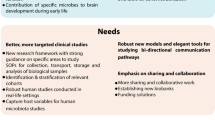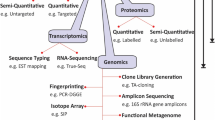Abstract
There has been great interest in unraveling the complex inter-relationships between microbes and humans as they relate to human health and disease. This review will focus on recent advances in the appreciation and understanding of these relationships in terms of the upper respiratory tract, specifically the nose and paranasal sinuses.
Similar content being viewed by others
Abbreviations
- CNS:
-
Coagulase-negative Staphylococcus
- CRS:
-
Chronic rhinosinusitis
- CSLM:
-
Confocal scanning laser microscopy
- FISH:
-
Fluorescence in situ hybridization
- HC:
-
Healthy control(s)
- hBD:
-
Human beta defensin
- IESA:
-
Intraepithelial Staphyloccus aureus
- MRSA:
-
Methicillin-resistant Staphylococcus aureus
- NO:
-
Nitric oxide
- OTU:
-
Operational taxonomic unit
- SEM:
-
Scanning electron microscopy
- T2R38:
-
A bitter taste receptor
- TAS2R38:
-
A bitter taste receptor polymorphism
- TEM:
-
Transmission electron microscopy
- TLR:
-
Toll-like receptor
References
Papers of particular interest, published recently, have been highlighted as: • Of importance •• Of major importance
Lemon KP, Klepac-Ceraj V, Schiffer HK, Brodie EL, Lynch SV, Kolter R. Comparative analyses of the bacterial microbiota of the human nostril and oropharynx. mBio. 2010;1(3):e00129-10. This is a study of the bacterial microbiota of the nostril and posterior wall of the oropharynx from 7 healthy adults using a 16S rRNA gene microarray (PhyloChip) and 16S rRNA gene clone libraries showing that the PhyloChip is orders of magnitude more sensitive in its ability to identify diversity and for detecting low abundance taxa.
Nikolaki S, Tsiamis G. Microbial diversity in the era of omic technologies. BioMed Res Int. 2013;2013:958719. This is a excellent review of molecular tools used to study microbial communities.
He Z, Deng Y, Zhou J. Development of functional gene microarrays for microbial community analysis. Curr Opin Biotechnol. 2012;23(1):49–55. This is a review of functional gene arrays (FGAs), a special type of microarrays containing probes for key genes involved in microbial functional processes, and the application of FGAs to examine the human microbiome.
Ecker DJ, Sampath R, Massire C, Blyn LB, Hall TA, Eshoo MW, et al. Ibis T5000: a universal biosensor approach for microbiology. Nat Rev Microbiol. 2008;6(7):553–8. This study described the Ibis T5000, a platform that couples nucleic acid amplification to high-performance electrospray ionization mass spectrometry and base-composition analysis to identify pathogens in clinical and environmental samples.
Handelsman J, Rondon MR, Brady SF, Clardy J, Goodman RM. Molecular biological access to the chemistry of unknown soil microbes: a new frontier for natural products. Chem Biol. 1998;5(10):R245-9. This paper described the use of random shotgun metagenomics, a method by which total DNA is isolated from a sample and then sequenced to profile of all genes within the community, as a means of accessing the collective genomes and the biosynthetic machinery of soil microflora.
Peterson J, Garges S, Giovanni M, McInnes P, Wang L, Schloss JA, et al. The NIH Human Microbiome Project. Genome Res. 2009;19(12):2317–23. This study described the Human Microbiome Project (HMP), funded as an initiative of the NIH Roadmap for Biomedical Research, and describes the various types of data and database resources it provides.
The Human Microbiome Project Consortium. Structure, function and diversity of the healthy human microbiome. Nature. 2012;486(7402):207–14. This paper summarized the Human Microbiome Project’s analysis of the largest cohort and set of distinct, clinically relevant body habitats so far and delineating the range of structural and functional configurations in the microbial communities of a healthy population.
Gillespie JJ, Wattam AR, Cammer SA, Gabbard JL, Shukla MP, Dalay O, et al. PATRIC: the comprehensive bacterial bioinformatics resource with a focus on human pathogenic species. Infect Immun. 2011;79(11):4286–98. This paper described the Pathosystems Resource Integration Center (PATRIC), a genomics-centric relational database and bioinformatics resource that provides scientists with (i) a comprehensive bacterial genomics database, (ii) a plethora of associated data relevant to genomic analysis, and (iii) an extensive suite of computational tools and platforms for bioinformatics analysis.
den Heijer CD, van Bijnen EM, Paget WJ, Pringle M, Goossens H, Bruggeman CA, et al. Prevalence and resistance of commensal Staphylococcus aureus, including meticillin-resistant S aureus, in nine European countries: a cross-sectional study. Lancet Infect Dis. 2013;13(5):409–15. This study examined the prevalence of nasal S aureus carriage and antibiotic resistance, including meticillin-resistant S aureus (MRSA), in healthy patients across nine European countries using nasal swabs.
Frank DN, Feazel LM, Bessesen MT, Price CS, Janoff EN, Pace NR. The human nasal microbiota and Staphylococcus aureus carriage. PLoS One. 2010;5(5):e10598. This study examined nasal specimens from 5 healthy adults and hospitalized patients (including 26 S aureus carriers and 16 non-carriers) using 16S rRNA sequences and demonstrated a negative association between S aureus, S epidermidis, and other groups suggests microbial competition during colonization of the nares.
Gosbell IB, van Hal SJ. Staphylococcus aureus colonisation: some questions answered. Lancet Infect Dis. 2013;13(5):380–1. This is an editorial regarding the den Heijer paper (reference 9) and the prevalence of S aureus and MRSA carriage across the world and their implications for public health measures.
Yan M, Pamp SJ, Fukuyama J, Hwang PH, Cho DY, Holmes S, et al. Nasal microenvironments and interspecific interactions influence nasal microbiota complexity and S aureus carriage. Cell Host Microbe. 2013;14(6):631–40. This study examined healthy subjects, both S aureus carriers and noncarriers, at the anterior naris, middle meatus, and sphenoethmoidal recess using phylogenetic compositional and sparse linear discriminant analyses and identified microbial community determinants of S aureus carriage at sites with ciliated pseudostratified columnar epithelium.
Ramakrishnan VR, Feazel LM, Gitomer SA, Ir D, Robertson CE, Frank DN. The microbiome of the middle meatus in healthy adults. PLoS One. 2013;8(12):e85507. This study examined the microbiome of the middle meatus in healthy adults using middle meatus swabs, quantitative PCR and 16S rRNA pyrosequencing thereby establishing a baseline for understanding how the sinonasal microbiome may impact diseases.
Abreu NA, Nagalingam NA, Song Y, Roediger FC, Pletcher SD, Goldberg AN, et al. Sinus microbiome diversity depletion and Corynebacterium tuberculostearicum enrichment mediates rhinosinusitis. Sci Transl Med. 2012;4(151):151ra24. This study compared sinus brushings from 10 healthy non-CRS controls and 7 CRS patients using a phylogenetic microarray and identified a protective role for the taxon Lactobacillales (that includes Lactobacillus sakei) and a pathogenic role for Corynebacteriaceae (including the organism Corynebacteium tuberculostericum) in CRS.
Hamilos DL. Host-microbial interactions in patients with chronic rhinosinusitis. J Allergy Clin Immunol. 2014;133(3):640.e4–53.e4. This is a state-of-the-art review of evidence for microbial involvement in CRS (viral, bacterial and fungal) and the role of host mucociliary clearance and mucosal innate immunity as they relate to mucosal susceptibility toward microbial infection and the pathogenesis of CRS.
Psaltis AJ, Ha KR, Beule AG, Tan LW, Wormald PJ. Confocal scanning laser microscopy evidence of biofilms in patients with chronic rhinosinusitis. Laryngoscope. 2007;117(7):1302–6. This study investigate biofilm presence in 38 CRS patients and 9 non-CRS controls using CSLM and identified biofilm in 44 % of CRS patients and none of the non-CRS controls.
Oncel S, Pinar E, Sener G, Calli C, Karagoz U. Evaluation of bacterial biofilms in chronic rhinosinusitis. J Otolaryngol Head Neck Surg Le Journal d’oto-rhino-laryngologie et de chirurgie cervico-faciale. 2010;39(1):52–5. This is a systematic evaluation of biofilm production by nasal swab culture of patients with CRS undergoing sinus surgery that revealed biofilm production in 9 of 13 S. aureus cultures and 6 of 10 P. auruginosa cultures.
Stephenson MF, Mfuna L, Dowd SE, Wolcott RD, Barbeau J, Poisson M, et al. Molecular characterization of the polymicrobial flora in chronic rhinosinusitis. J Otolaryngol Head Neck Surgy = Le Journal d’oto-rhino-laryngologie et de chirurgie cervico-faciale. 2010;39(2):182–7. This is a study of molecular culture of mucosal biopsies from CRS patients undergoing sinus surgery and control non-CRS surgical patients. Compared to conventional culture, molecular culture revealed a much broader array or organisms (up to 20 per sample) among the CRS patients with a predominance of anaerobic species and 50 % prevalence of S aureus.
Brook I, Frazier EH. Correlation between microbiology and previous sinus surgery in patients with chronic maxillary sinusitis. Ann Otol Rhinol Laryngol. 2001;110(2):148–51. This study perfomed culture and analysis of aspirates from 108 chronically inflamed maxillary sinuses ultimately correlating microbial results with previous sinus surgery and finding higher prevalence of P. aeruginosa and gram negative aerobic bacilli and a lower prevalence of anaerobes among patients with previous surgery.
Finegold SM, Flynn MJ, Rose FV, Jousimies-Somer H, Jakielaszek C, McTeague M, et al. Bacteriologic findings associated with chronic bacterial maxillary sinusitis in adults. Clin Infect Dis Off Public Infect Dis Soc Am. 2002;35(4):428–33. This study was an analysis of bacterial cultures from patients with bacterial maxillary sinusitis that recovered aerobes in 52.2 % and anaerobes in 47.8 % of cases and found that recurrence of sinusitis was associated with counts of anaerobes > or =10(3) cfu/mL.
Donlan RM, Costerton JW. Biofilms: survival mechanisms of clinically relevant microorganisms. Clin Microbiol Rev. 2002;15(2):167–93. This review discussed biofilms, their structure, role in disease and microbial resistance and involvement of medical devices.
Cryer J, Schipor I, Perloff JR, Palmer JN. Evidence of bacterial biofilms in human chronic sinusitis. ORL J Otorhinolaryngology Relat Spec. 2004;66(3):155–8. This study used electron microscopy to confirm the presence of biofilms on sinus mucosa of patients with recalcitrant chronic sinusitis and identified them in patients infected with P. aeruginosa.
Corriveau MN, Zhang N, Holtappels G, Van Roy N, Bachert C. Detection of Staphylococcus aureus in nasal tissue with peptide nucleic acid-fluorescence in situ hybridization. Am J Rhinol Allergy. 2009;23(5):461–5. This study described the detection of intramucosal Staphylococcus aureus within nasal tissue in patients with CRS using a peptide nucleic acid-FISH technique.
Tan NC, Foreman A, Jardeleza C, Douglas R, Tran H, Wormald PJ. The multiplicity of Staphylococcus aureus in chronic rhinosinusitis: correlating surface biofilm and intracellular residence. Laryngoscope. 2012;122(8):1655–60. This study used FISH and confocal scanning laser microscopy to identify intracellular S. aureus in 56 % of CRS and 0 % of control non-CRS patients suggesting a role for intracellular S aureus in CRS and an association with the presence of biofilm.
Feazel LM, Robertson CE, Ramakrishnan VR, Frank DN. Microbiome complexity and Staphylococcus aureus in chronic rhinosinusitis. Laryngoscope. 2012;122(2):467–72. This study compared conventional culture techniques and DNA pyrosequencing of middle meatus swabs during sinus surgery on CRS patients and non-CRS controls and demonstated increased biodiversity identifiable by DNA pyrosequencing when compared to bacterial culture as well as altered microbial composition and greater abundance of S aureus in CRS patients.
Boase S, Foreman A, Cleland E, Tan L, Melton-Kreft R, Pant H, et al. The microbiome of chronic rhinosinusitis: culture, molecular diagnostics and biofilm detection. BMC Infect Dis. 2013;13:210. This study used multiple techniques to characterize bacterial and fungal unvolvement of sinonasal mucosa in CRS patients and controls including conventional culture, PCR coupled with electrospray ionization time-of-flight mass spectrometry, and FISH and found an increased abundance of S aureus in CRS.
Choi EB, Hong SW, Kim DK, Jeon SG, Kim KR, Cho SH, et al. Decreased diversity of nasal microbiota and their secreted extracellular vesicles in patients with chronic rhinosinusitis based on a metagenomic analysis. Allergy. 2014;69(4):517–26. This study evaluated the microbiota and extracellular vesicles in CRS patients with and without polyposis and non-CRS controls using pyrosequencing to quantify diversity and abundance and found decreased abundance of Bacteroidetes and increased abundance of Firmicutes in CRS patients.
Unal CM, Schaar V, Riesbeck K. Bacterial outer membrane vesicles in disease and preventive medicine. Semin Immunopathol. 2011;33(5):395–408. This is a review of outer membrane vesicles and their role in virulence, inducing immune responses and as potential therapeutic targets.
Biller SJ, Schubotz F, Roggensack SE, Thompson AW, Summons RE, Chisholm SW. Bacterial vesicles in marine ecosystems. Science. 2014;343(6167):183–6. This study characterized extracellular vesicle production and function among marine bacteria.
Kim MR, Hong SW, Choi EB, Lee WH, Kim YS, Jeon SG, et al. Staphylococcus aureus-derived extracellular vesicles induce neutrophilic pulmonary inflammation via both Th1 and Th17 cell responses. Allergy. 2012;67(10):1271–81. This study evaluated innate immune responses in vitro after the application of extracellular vesicles from S. aureus to airway epithelial cells and alveolar macrophages as well as combining EV with ovalbumin for in vivo sensitization studies demonstrating induction of Th1 and Th17 immune responses.
Aurora R, Chatterjee D, Hentzleman J, Prasad G, Sindwani R, Sanford T. Contrasting the microbiomes from healthy volunteers and patients with chronic rhinosinusitis. JAMA Otolaryngol Head Neck Surg. 2013;139(12):1328–38. This study analyzed the microbiome of CRS patients and healthy controls using deep sequencing of bacterial 16S and fungal 18S ribosomal RNA genes suggesting a similar composition of the microbiomes between patients and controls but an altered immune response to normal commensal bacteria among the CRS patients.
Lee RJ, Xiong G, Kofonow JM, Chen B, Lysenko A, Jiang P, et al. T2R38 taste receptor polymorphisms underlie susceptibility to upper respiratory infection. J Clin Invest. 2012;122(11):4145–59. This study demonstrates the expression of the bitter taste receptor, T2R38, in upper respiratory epithelium and its activation in response to acyl-homoserine lactone quorum-sensing molecules secreted by P aeruginosa and other gram negative bacteria resulting in NO production and increased mucociliary clearance.
Compliance with Ethics Guidelines
Conflict of Interest
Michael T. Wilson and Daniel L. Hamilos report no conflict of interest.
Human and Animal Rights and Informed Consent
This article does not contain any studies with human or animal subjects performed by the authors.
Author information
Authors and Affiliations
Corresponding author
Additional information
This article is part of the Topical Collection on Rhinosinusitis
Rights and permissions
About this article
Cite this article
Wilson, M.T., Hamilos, D.L. The Nasal and Sinus Microbiome in Health and Disease. Curr Allergy Asthma Rep 14, 485 (2014). https://doi.org/10.1007/s11882-014-0485-x
Published:
DOI: https://doi.org/10.1007/s11882-014-0485-x




